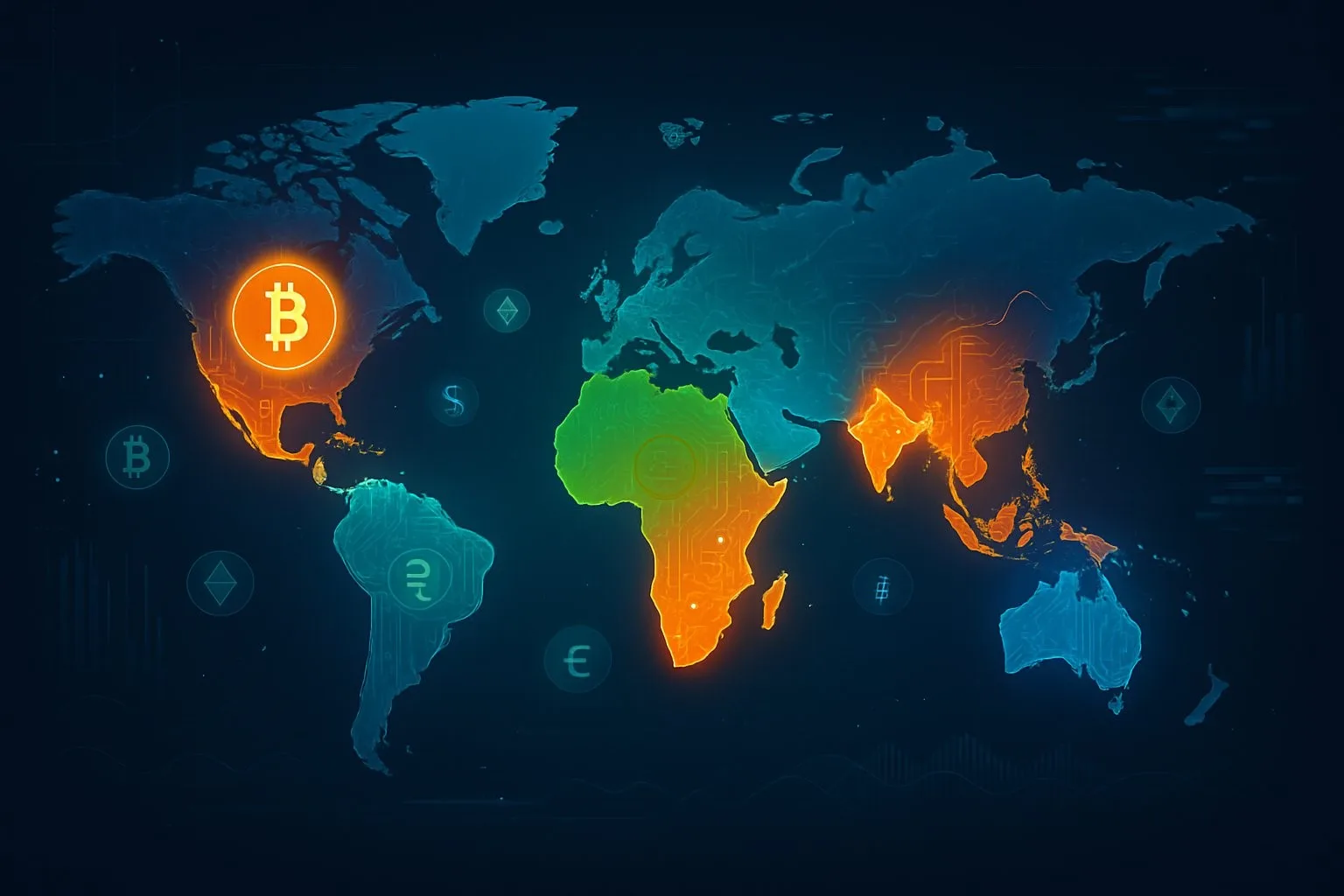Top Countries With High Cryptocurrency Usage: Five Nations Driving Digital Asset Adoption
Cryptocurrency adoption has reached new heights across the globe in 2025, with millions of people embracing digital currencies for various purposes ranging from everyday transactions to investment strategies. Different countries show varying levels of crypto usage based on economic conditions, regulatory frameworks, and technological infrastructure.
Several nations have emerged as clear leaders in cryptocurrency adoption, each driven by unique factors such as population size, economic necessity, and government policies. The landscape reveals interesting patterns where some countries lead in total user numbers while others dominate in ownership rates per capita. Understanding these adoption trends provides valuable insights into how digital currencies are reshaping global financial systems and which regions are at the forefront of this technological shift.
1) India leads global cryptocurrency adoption with over 93 million owners
India holds the top spot in the 2025 Global Crypto Adoption Index for the third consecutive year. The country leads all other nations in cryptocurrency usage across multiple categories.
Chainalysis ranks India first in four key areas. These include retail transactions, centralized service use, DeFi volumes, and institutional activity.
The country’s dominance stems from widespread adoption across different user groups. Both individual investors and institutions actively participate in India’s crypto market.
India outpaces 151 countries analyzed in the comprehensive study. The United States ranks second, but India maintains a clear lead in overall adoption metrics.
The nation’s large smartphone user base of 750 million people supports this growth. This massive mobile infrastructure makes crypto access easier for millions of Indians.
India’s crypto market continues expanding despite regulatory challenges. Traders face taxation issues and uncertain government policies, yet adoption rates keep rising.
The country shows strong performance in both retail and institutional segments. This balanced growth across user types sets India apart from other major crypto markets worldwide.
2) Nigeria ranks second in worldwide crypto usage driven by economic factors
Nigeria holds the second position globally in cryptocurrency adoption according to multiple reports from 2025. The country has 25.9 million people using digital assets, which equals 11.9% of the population.
Economic challenges drive Nigeria’s high crypto usage. The country faces inflation and a volatile currency that pushes people toward digital assets as alternatives.
Young, tech-savvy citizens embrace cryptocurrency solutions. They use crypto to handle money transfers, savings, and business transactions when traditional banking falls short.
Nigeria leads the world in stablecoin adoption specifically. These digital currencies tied to stable values help people avoid currency fluctuations.
The country recorded $59 billion in cryptocurrency transactions over the past year. This massive volume shows how deeply crypto has entered Nigeria’s financial system.
Limited access to traditional banking services creates demand for crypto solutions. Digital assets offer financial services to people who cannot easily use regular banks.
Nigeria’s position as Africa’s largest economy makes its crypto adoption significant. The country influences digital asset trends across the entire continent.
3) Indonesia holds third place in the global cryptocurrency adoption index.
Indonesia made its debut in the Chainalysis Global Crypto Adoption Index and immediately secured the third position. This ranking marks a significant milestone for the Southeast Asian nation in the digital asset landscape.
The country surpassed Vietnam to claim this spot. Indonesia now ranks behind only India and Nigeria, which continue to hold the top two positions.
Indonesia’s cryptocurrency market recorded $157 billion in value inflows between 2023-2024. This massive surge demonstrates the country’s growing influence in the global crypto economy.
The nation’s rise coincides with increased global cryptocurrency activity. Crypto usage has reached levels not seen since the 2021 bull market peak.
Asia dominates the crypto adoption rankings, with nine of the top 20 countries coming from this region. Indonesia’s third-place position strengthens Asia’s leadership in cryptocurrency usage worldwide.
The country’s ranking reflects its strength as a retail-driven market. Indonesian users are actively participating in cryptocurrency trading and digital asset activities, contributing to the nation’s rapid climb in global adoption metrics.
4) United States is fourth, known for widespread crypto integration.
The United States holds a strong position in global crypto adoption. The country has 52.8 million cryptocurrency holders, representing 15.56% of its population.
America leads among developed nations in crypto usage. The country has built a robust cryptocurrency industry with major exchanges and blockchain technology companies.
The US has created sophisticated regulatory frameworks for digital assets. These rules focus on institutional participation and investor protection. They help integrate crypto with existing financial systems.
Professional involvement runs deep in American crypto markets. The country offers cryptocurrency ETFs and other investment products. This makes it easier for traditional investors to access digital assets.
In the US, cryptocurrency functions mainly as an investment tool. People also view it as part of the technological frontier. This differs from developing countries where crypto serves as everyday money.
The American crypto ecosystem attracts major institutional players. Banks, investment firms, and corporations actively participate in the market. This institutional support strengthens the country’s crypto infrastructure.
The US crypto market continues to grow and mature. Strong regulations and institutional backing position America as a key player in global cryptocurrency adoption.
5) United Arab Emirates boasts the highest crypto ownership rate at 25.3%
The United Arab Emirates leads the world in cryptocurrency ownership rates. Over 25% of its population owns digital assets, making it the top-ranked country globally.
This high ownership rate reflects the UAE’s strong crypto adoption. The country scored 98.4 out of 100 in recent crypto obsession rankings.
The UAE has experienced remarkable growth in digital asset adoption. Crypto adoption in the country has surged by 210% in 2025.
About 3 million people in the UAE own cryptocurrency. This represents nearly one in four residents participating in the digital asset market.
The country’s success stems from supportive regulations and government policies. The Financial Services Regulatory Authority was among the first to establish clear rules for crypto trading.
Singapore ranks as another highly crypto-obsessed nation alongside the UAE. However, the UAE maintains its position as the leader in ownership percentages.
The UAE’s tech-savvy population has embraced digital currencies quickly. Forward-thinking regulations have created a favorable environment for crypto investment and usage.
Factors Driving Cryptocurrency Adoption in 2025
Government policies and regulatory clarity have become major forces shaping crypto adoption worldwide. Advanced fintech systems and better infrastructure make digital assets easier to use for everyday people.
Regulatory Environment and Government Policies
Clear regulations have boosted crypto adoption in many countries this year. Nations with well-defined legal frameworks see higher usage rates than those with unclear rules.
The United States leads in institutional adoption partly due to regulatory progress. New policies allow more financial firms to offer crypto services. This creates trust among traditional investors.
India maintains the top spot for grassroots adoption despite strict regulations. The government focuses on controlling rather than banning crypto use. This approach lets people use digital assets while maintaining oversight.
Key regulatory drivers include:
- Legal clarity for businesses
- Tax guidelines for users
- Banking support for crypto companies
- Consumer protection laws
Countries with supportive policies attract more crypto businesses. These companies build local infrastructure that makes adoption easier for regular users.
Fintech Innovation and Infrastructure
Better technology makes crypto easier to use in 2025. Mobile apps now offer simple ways to buy, sell, and spend digital assets. Payment systems work faster and cost less than before.
Asia-Pacific leads global growth with 69% year-over-year increases. This region has strong mobile payment systems that work well with crypto. People already use digital payments daily.
Exchange platforms now offer better security and user experiences. Local payment methods connect traditional banking with crypto services. This bridge helps new users start using digital assets.
Infrastructure improvements include:
- Faster transaction processing
- Lower fees for transfers
- Better mobile wallet design
- More merchant acceptance
Countries with advanced fintech sectors see higher adoption rates. Strong internet networks and smartphone usage support crypto growth.
Socioeconomic Trends Impacting Usage
Economic needs drive crypto adoption in different ways across countries. Lower-income nations use digital assets for practical purposes like sending money home and protecting savings from inflation.
Remittances represent a major use case in 2025. Workers send money across borders using crypto because it costs less than traditional services. Countries like Pakistan and Vietnam benefit from this trend.
High-income countries focus more on investment and trading. People use crypto to diversify their portfolios and access new financial products. Institutional investors drive much of this activity.
Economic factors include:
- Inflation protection needs
- Cross-border payment demands
- Investment opportunities
- Financial inclusion goals
Young populations adopt crypto faster than older groups. Countries with more young adults see higher usage rates. These users grew up with digital technology and trust new financial systems.
Comparative Analysis of Crypto Usage Trends
Different countries show distinct patterns in how they use cryptocurrency, with some focusing on daily transactions while others treat it mainly as an investment. Geographic location and demographics play major roles in adoption, as does how well crypto fits with traditional banking systems.
Transactional Use Cases Versus Investment
Lower-income countries lead in real-world crypto usage for everyday needs. These nations use cryptocurrency primarily for remittances, payments, and protecting against inflation.
Nigeria stands out as a prime example. The country ranks second globally for crypto usage, with citizens using stablecoins to escape high inflation and currency problems. Stablecoins make up 43% of all crypto volume in Sub-Saharan Africa.
High-income countries take a different approach. They focus more on cryptocurrency as an investment vehicle rather than for daily transactions.
These wealthy nations emphasize regulatory frameworks and investment products. People buy crypto to diversify portfolios or speculate on price movements. They rarely use it to buy groceries or send money to family.
Demographic and Geographic Patterns
Sub-Saharan Africa shows the highest growth in grassroots crypto adoption. Countries in this region face currency instability and limited banking access, making crypto attractive.
Young adults drive most crypto adoption worldwide. People under 35 are more likely to own and use cryptocurrency than older generations.
Urban areas see higher adoption rates than rural regions. Cities offer better internet access and more tech-savvy populations.
Middle-income countries often rank highest in overall usage indexes. They have enough economic instability to need crypto but sufficient infrastructure to support it.
Geographic clusters emerge around specific use cases. Latin American countries focus on remittances. Asian nations emphasize trading and investment.
Integration With Existing Financial Systems
Countries with weak traditional banking show higher crypto adoption for basic financial services. People use cryptocurrency to store value, send money, and make payments when banks are unreliable.
Nations with strong financial systems see crypto as a complement rather than replacement. Banks in these countries often offer crypto services or partner with crypto companies.
Regulatory approaches vary widely between regions. Some countries create clear legal frameworks that encourage integration. Others remain in legal gray areas or ban crypto entirely.
Payment integration happens faster in countries with existing digital payment systems. Mobile money platforms in Africa easily add crypto features. Cash-heavy economies struggle with crypto adoption.
Cross-border payments drive integration in many developing nations. Traditional wire transfers are expensive and slow, making crypto attractive for international transactions.





